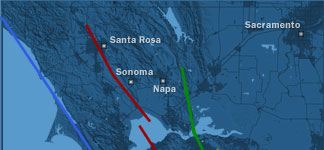 |
 |
 |
 |
Posted: March 20,
2006 |
|
   |
 |
 |
The Earth's crust is broken up into plates that move slowly, causing a buildup of pressure in certain areas that rupture when the pressure becomes too great. These breaks in the Earth's surface, or faults, are where earthquakes occur. The San Francisco Bay area is home to seven major fault lines, the largest being the San Andreas Fault which stretches for 800 miles along the California coast. For each fault, scientists assigned a percentage of probability for when a major earthquake -- of magnitude 6.7 or greater -- might occur.
Click on each fault to get more information. |
 |
|
|
 |
|
 |





